“To enforce this policy, states and NGOs use Skylight to identify suspicious activity, such as potential transshipment, for port authorities enforcing AMERP actions,” he added.
What is computer vision?
This is an area of artificial intelligence (AI) that helps computers find important information in digital images and videos and then take action or make recommendations. Based on IBM“If AI allows computers to think, computer vision enables them to see, observe, and understand.”
This technology uses tools such as satellite imagery, “computer vision” and machine learning to analyze data and detect suspicious activity in real time. By definition, the high seas are distant seas, making it impractical to have ships and surveillance patrols.
“You really have to do remote sensing, at the very least, to know where to do monitoring, so… when you send in Coast Guards, planes and drones, chances are there really is something there,” Schmitt said.
As criminals try to get ahead by turning off their tracking systems to avoid detection near protected or restricted areas, developers are forced to work faster and stay ahead.
To support this technology, Skylight offers training to government and NGO representatives. That Joint Analytical Cell (JAC) is a group of organizations, including Global Fishing Watch and Tracking platform Trygg Mat, working to ensure technology reaches the right people and serves its purpose.
Currently, Skylight is primarily focused on monitoring the exclusive economic zone, but as the high seas agreement progresses, the platform will reportedly develop systems to extend its coverage in far-flung waters. The challenge, Schmitt explained to China Dialogue Ocean, is accessing satellite imagery for the high seas, because images are often not freely available and expensive to obtain, areas where JAC can help improve access. .
What areas must be protected? Animals with GPS could have the answer
One of the main outcomes of the high seas treaty will help establish marine protected areas in these waters. But how will they be appointed? What should be the priority in protecting parts of the ocean?
On the high seas, in the northeast Atlantic, for example, six protection zones were defined in 2010, under the Northeast Atlantic Convention for the Protection of the Marine Environment, commonly referred to as the OSPAR Agreement. Since then, four more OSPAR Marine Protected Areas (MPAs) have been established.
A article published in 2021 in the Journal of Applied Ecology describes how the first six OSPAR buffer zones are defined largely for their benthic features—which are found at the lowest levels near the ocean floor—including fracture zones and ridges. But their authors, like other observers, argue that other marine life forms, such as seabirds, have not been accounted for. Animal tracking data can prove valuable in situations like this.

Marine biologist Guy Harvey is a proponent of this approach. His organization, the Guy Harvey Foundation, uses GPS tracking of marine animals to determine potential MPA areas.
In 2018, for example, Harvey tagged a whale shark near Mexico’s Caribbean coast that by 2022 had traveled 19,000 miles: through the Gulf of Mexico into Colombian waters, then north to the Florida coast, off the Atlantic coast, and once through the Caribbean Sea. more before reaching Cuba.
In conference our oceans, which was conducted in Panama last March, Harvey explains that this type of mapping can help understand migration patterns and habitats of species, as well as suggest locations for new MPAs. When comparing this data with areas that are already protected, discrepancies often occur, explains Harvey.
Elsewhere, there are also initiatives that use data on bird migration patterns to identify important marine areas. BirdLife International, a global association of NGOs, analyzed the routes of 2,000 seabirds from Seabird Tracking Database. Thus, an Important Bird and Biodiversity Area (IBA) was identified, which is now renamed the Evlanov-North Atlantic Ocean Current MPA, or BORN AMP.
Up to 5 million birds use the area year-round, making it an important meeting point for migratory seabirds from around the world. The OSPAR Commission officially designated NACES in 2021, and this is the first MPA to use tracking data to identify them. It is larger in area than England and Germany combined, although it still is was arguing scope of application and management.
Technology challenges
There are other technological tools that can help protect the high seas, such as autonomous submarine who explore the bottom of these waters and non-profit satellite monitoring SkyTruth, which serves to identify oil spills. The latter is the first to provide evidence that BP’s oil spill following the Deepwater Horizon disaster in 2010 was much larger than originally thought.
“All of these tools have advanced very quickly, but the big challenge now is to see how they feed into decision-making,” said Octavio Aburto. He added that such tools are “still in a very technological and scientific phase,” and that governments often do not have the resources or capacity to train prefectures and their armed forces to participate in monitoring and enforcement efforts on the high seas.
The big challenge now is to see how this technology feeds into decision-making
Barriers to effectively protecting the high seas can arise from the need to balance initiatives with commercial interests, regardless of whether current practices are unsustainable or depleting fish stocks. As the treaty is implemented, it should also become clearer how it will interact, in practice, with other existing agreements, such as those governing shipping under the International Maritime Organization.
The absence of a global governance framework has made a coordinated approach to conservation measures on the high seas impossible. The new agreement opens up the possibility for governments and civil society to submit proposals for the protection of the high seas. The results will be seen in the coming years, when the agreement is implemented.
This article was originally published on China Sea of Dialogue.

“Entrepreneur. Internet fanatic. Certified zombie scholar. Friendly troublemaker. Bacon expert.”







